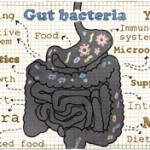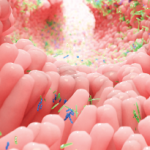BOSTON—Intestinal bacterial composition and activity play a role in the development of several autoimmune rheumatic diseases. A panel of experts addressed Emerging Perspectives on the Microbiome in the Rheumatic Diseases at the Basic Research Conference prior to the start of the ACR/ARHP Annual Meeting in Boston on Nov. 15, 2014. Gut microbiota may help rheumatologists identify who is most at risk for developing such diseases as ankylosing spondylitis (AS), uveitis, inflammatory bowel disease (IBS) and rheumatoid arthritis (RA), and facilitate more effective therapies, such as fecal transplants.
Genes & Bugs

Genes, such as HLA-B27, may also play a strong role in a patient’s predisposition to developing certain fecal microbiota that trigger inflammatory diseases. In AS, a disease strongly associated with HLA-B27, increased bowel permeability is common, said James T. Rosenbaum, MD, head of the Division of Arthritis and Rheumatic Diseases at Oregon Health and Science University in Portland.
“Dispersion of bacteria from this leaky gut, if it goes to the joints, can lead to inflammation,” said Dr. Rosenbaum. Reactive arthritis is a good example of this phenomenon, but the mechanism is less clear in AS. Researchers recently found that bacteria from tick larvae contributed to the development of Lyme disease, providing an important clue to the bug–disease connection. The bacteria in the tick determine if the spirochete that causes Lyme can proliferate in the tick. “This was a wow to me, a completely unexpected link between the microbiome and one of our rheumatic diseases.”
Rheumatologists may one day be able to prevent inflammatory diseases, such as uveitis or AS, by manipulating patients’ microbiomes despite their DNA, Dr. Rosenbaum said. “Environment is important, and genes are important. Both play a role.”
Triggering Effects
In RA, patients may go through years of preclinical disease when they have evidence of potential triggers, such as anticitrullinated peptide antibody (ACPA). They may develop early synovitis due to environmental exposures, said Jose U. Scher, MD, assistant professor of medicine at New York University Langone Medical Center in New York City.

ACPA and other autoantibodies don’t explain all the changes in RA pathogenesis, and some people who test positive for them have normal synovia, said Dr. Scher. Something else may swoop in to trigger inflammation and activate the disease. “What is the second hit? Can we find an extra-articular source for the pathogenesis of RA?” he asked.
Mucosal bacteria evident in periodontal disease, such as P. gingivalis, is one likely trigger, Dr. Scher said. These flora express peptidyl arginine deiminase (PAD), and antibodies to P. gingivalis are significantly higher in RA patients. “But P. gingivalis’ prevalence correlates with periodontal disease, not arthritis status. Maybe it’s not only P. gingivalis,” said Dr. Scher. “You can have similar microorganisms, but in separate mucosal sites” such as the lung or gut. Prevotella, an intestinal bug that decreases with a high-fat diet, may help predict who will respond better to RA treatments that are metabolized in the gut, like methotrexate, he said.
Diet’s Impact
Could changing from carnivore to vegan positively affect a patient with inflammatory disease? “You can change microbial composition, but it takes a long time to make that change,” said Jonathan Braun, MD, PhD, professor of pathology and laboratory medicine at the University of California, Los Angeles, Geffen School of Medicine. In pediatric Crohn’s disease, gut dysbiosis is a prominent feature and often, the same bugs are found in the patient’s family. Parents and children often eat the same foods, he said.
Despite popular health claims, probiotics in foods like yogurt don’t change microbial composition, but they may change how they function in the gut, said Dr. Braun. Metabolites found in colonic samples may offer more accurate signs that a person is at risk for Crohn’s disease or inflammatory bowel disease (IBD), he added.
As many as 30 genes may “garden” our intestinal flora, and three that specifically affect susceptibility to inflammatory bowel disease are COSMC, Core 1 O-glycanase and Fut2, said Dr. Braun.
B Cell Expression
Microbiota also plays a role in protecting against systemic lupus erythematosus (SLE). Gut-associated lymphoid tissue (GALT) is a site of chronic B cell activation, said Jo Spencer, PhD, professor of immunobiology at King’s College in London.
“GALT generates the largest percentage of plasma cells in the body, most of which secrete immunoglobulin A (IgA),” said Dr. Spencer. “Our data suggest that in addition to this well-known function of GALT, exposure to microbiota in this microenvironment may support early stages of human B cell development in health.”
This process appears to go awry in SLE. “Unexpectedly, we found dramatic reduction in expression of β7 integrin by B cells in SLE patients,” said Dr. Spencer. “So we think GALT is compromised. IgA plasma cells are relatively less frequent,” and B cell development may also be perturbed in SLE patients as a consequence, she said. The reduced expression of β7 integrin by B cells in SLE is still apparent when B cells repopulate the blood after rituximab treatment.
Prebiotics & Probiotics
Although such foods as yogurt or kombucha may not live up to their lofty reputations, selectively fermented ingredients that allow specific changes in the composition or activity of gastrointestinal flora may confer health benefits, said David Mills, PhD, professor of food science and technology at the University of California in Davis. Probiotics delivered through breast milk to infants with necrotizing enterocolitis seem to help their symptoms, but “we really need to get a mechanism to understand this,” he said.
Prebiotics are indigestible foods, such as fiber, that may be fermented by bacteria in the colon, stimulating the growth of healthful bacteria, said Dr. Mills. Prebiotic intake may help reduce the prevalence or duration of infectious or antibiotic-associated diarrhea and reduce IBD inflammation, he said.
Breast milk is one food that combines probiotics, prebiotics and nutraceuticals, and serves to both feed the infant and modulate its microbial composition, said Dr. Mills. Lactoferrin in breast milk specifically leads to the production of probiotic enzymes, and milk expresses proteases that yield protective antimicrobial peptides.
Helpful Helminths
Our modern practices of hygiene, including the use of antibiotics and antiseptic cleansers, have altered the composition of the organisms living in our gastrointestinal tract, said Joel Weinstock, MD, professor of medicine at Tufts University in Boston. Helminths, or intestinal worms, once lived in our gut. They are now gone. Their presence may help prevent and treat autoimmunity, he said.
Helminthic infections are more common in the developing world, where hygiene and food safety are poor. There are signs that the immune systems of people with helminthic infections are better regulated and inhibit excess reactivity, which in turn, decreases our likelihood of getting immune-mediated diseases, such as Crohn’s disease and ulcerative colitis (UC).
“But I’m not an enemy of hygiene!” Dr. Weinstock said. Improved sanitation helps control water-borne diseases, such as cholera. “Not all organisms make us sick, and some may protect us. But we’re eliminating all of those too.” A thin layer of mucosa in the gut and our intestinal immune system protects it from absorbing intestinal bacteria, but an overactive immune system directed against these bacteria can damage the intestinal epithelial lining and cause disease, said Dr. Weinstock.

Helminths live in the gut lumen. They may modulate the immune response and protect us from certain autoimmune diseases, such as UC, he said. People exposed to eggs of trichuris suis, the porcine whipworm, may be less susceptible to UC, for example. Helminthic infections may activate regulatory T cells and induce regulatory dendritic cells that help control colitis, he said.
Someday, doctors may be able to harness these parasites in the form of protective vaccines against immunological diseases, said Dr. Weinstock. “Indiscriminant exposure to a large variety of organisms in our environment also may decrease the incidence of these diseases.” However, “nobody wants to go back to living in filth.”
Microbial Gardening
Bacteria help trigger urinary tract and other vaginal infections in women, said Gregor Reid, PhD, MBA, a professor of microbiology and immunology at the University of Western Ontario in London. After delivering a baby, mothers may have a sharp drop in levels of protective lactobacillus, he said.
Probiotic yogurt does not affect the vaginal flora when eaten, but it does help when used intravaginally, said Dr. Reid. Unlike the gut, the vagina’s microbial garden can be changed. “We have never thought of giving probiotics after delivery, but maybe we should. It would help her recover quicker,” he said. Probiotic lactobacillus may also help postmenopausal women prevent urinary tract infections, he added.
Ingested lactobacillus does help manipulate the antimicrobial defenses in the gut and can modulate immunity, said Dr. Reid. Probiotic yogurt may help prevent deadly, bacterial infections causing diarrhea in people living in developing regions like East Africa.
Fecal Transplants
Replacing harmful bacteria in the colon of sick patients with bacteria from healthy individuals has shown rapid, beneficial results, said Michael J. Sadowsky, PhD, director of the Biotechnology Institute at the University of Minnesota in St. Paul.

Many patients with C. difficile infection are prone to recurrence that doubles with each bounceback, Dr. Sadowsky said. Traditional treatments include specific antibiotics or tapered antibiotic therapy, but this is ineffective in many cases. Bacteriotherapy, or fecal microbiota transplantation (FMT) using a full-spectrum of fecal bacteria, is a new, more effective approach, he said.
Fecal bacteria donors go through rigorous, extensive screening. They must be adults who have had no recent antibiotics, no gastrointestinal ailments and no acute viral infections, Dr. Sadowsky said. Transplants are in frozen, standardized microbiota preparations and have no odor.
In an early trial, 11 of 12 patients with recurrent, antibiotic-resistant C. difficile infections improved within days after FMT, said Dr. Sadowsky. Now they have treated many hundreds. Only a few patients needed an additional treatment. Using endoscopy, the proximal colons of recipients appeared healthy and their microbial composition started to look like the donor’s, he said. Primary bile acid composition in the gut was lower after transplant, creating a less permissive environment for germination of C. difficile spores.
“You don’t even need high-tech imagery, because the patients themselves report relief within two days of receiving the material,” he said. Oral capsules may one day replace more expensive, invasive endoscopy delivery of the transplant, he added.
Susan Bernstein is a freelance medical journalist based in Atlanta.
Second Chance
If you missed this session, Emerging Perspectives on the Microbiome in the Rheumatic Diseases at the Basic Research Conference, it’s not too late. Catch it on SessionSelect: http://acr.peachnewmedia.com/store/provider/provider09.php.


